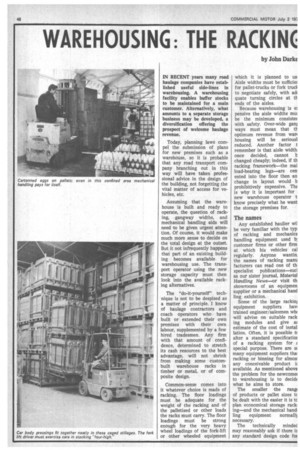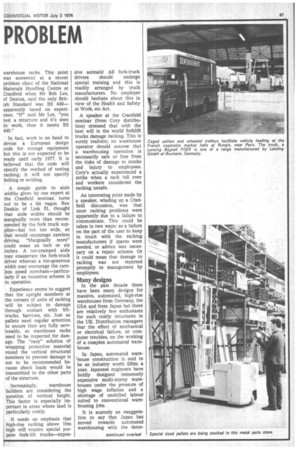WAREHOUSING: THE RACKING PROBLEM
Page 48

Page 49

Page 50

If you've noticed an error in this article please click here to report it so we can fix it.
by John Darke
IN RECENT years many road haulage companies have established useful side-lines in warehousing. A warehousing facility enables buffer stocks to be maintained for a main customer. Alternatively, what amounts to a separate storage business may be developed, a diversification offering the prospect of welcome haulage revenue.
Today, planning laws compel the submission of plans for new premises such as a warehouse, so it is probable that any road transport company branching out in this way will have taken professional advice in the design of the building, not forgetting the vital matter of access for vehicles, etc.
Assuming that the warehouse is built and ready to operate, the question of racking, gangway widths, and mechanical handling aids will need to be given urgent 'attention. Of course, it would make much more sense to decide on the total design at the outset. But it not infrequently happens that part of an existing building becomes available for warehousing use. The transport operator using the new storage capacity must then look into the available racking alternatives.
The "do-it-yourself" technique is not to be despised as a matter of principle. I know of haulage contractors and coach operators who have built or extended their own premises with their own labour, supplemented by a few hired tradesmen. Any firm with that amount of confidence, determined to stretch its cash resources to the best advantage, will not shrink from making some custombuilt warehouse racks in timber or metal, or of composite design.
Common-sense comes into it whatever choice is made of racking. The floor loadings must be adequate for the weight of the racking and of the palletised or other loads the racks must carry. The floor loadings must be strong enough for the very heavy wheel loadings of the fork-lift or other wheeled equipment which it is planned to usi Aisle widths must be sulfide/ for pallet-trucks or fork trucl. to negotiate safely, with acll quate turning circles at th ends of the aisles.
Because warehousing is e) pensive the aisle widths mu: be the minimum consister with safety. Over-wide ganj ways must mean that th optimum revenue from wan housing will be seriousl reduced. Another factor t remember is that aisle width: once decided, cannot b changed cheaply; indeed, if th racking framework—the mai load-bearing legs—are cerr ented into the floor then an change in layout would b prohibitively expensive. Tha is why it is important for new warehouse operator t know precisely what he want the storage premises for.
The names
Any established haulier wil be very familiar with the typ of racking and mechanica handling equipment used 13: customer firms or other firm at which his vehicles cal regularly. Anyone wantin; the names of racking manu facturers can read one of th, specialist publications—sucl as our sister journal, Material Handling News—or visit th showrooms of an equipmen• supplier or a mechanical hand ling exhibition.
Some of the large rackinj equipment suppliers hay( trained engineer/salesmen whc will advise on suitable rack ing modules and give at estimate of the cost of instal lation. Often, it is possible tc alter a standard specificatior of a racking system for E' special purpose. There are sc many equipment suppliers thai racking or binning for almosi any conceivable product available. As mentioned above the problem for the newcomer to warehousing is to decidE what he aims to store.
The smaller the rang of products or pallet sizes tc be dealt with the easier it is tc plan economical storage rack. ing—and the mechanical hand. ling equipment normally necessary.
The technically minded may reasonably ask if there is any standard design code for warehouse racks. This point was answered at a recent problem clinic of the National Materials Handling Centre at Cranfield when Mr Bob Lee, of Dexion, said the only British Standard was BS 449— apparently based on experience. "If" said Mr Lee, "you test a structure and it's seen to work, then it meets BS 449."
In fact, work is on hand to devise a European design code for storage equipment but this is not expected to be ready until early 1977. It is believed that the code will specify the method of testing racking; it will not specify bolting or welding.
A simple guide to aisle widths given by one expert at the Cranfield seminar, turns out to be a bit vague. Rex Deakin of Link 51, thought that aisle widths should be marginally more than recommended by the fork truck supplier—but not too wide, as that would encourage careless driving. "Marginally more" could mean an inch or six inches. A too-cramped aisle may exasperate the fork-truck driver whereas a too-generous width may encourage the careless speed merchant—particularly if an incentive scheme is in operation.
Experience seems to suggest that the upright members at the corners of units of racking will be subject to damage through contact with lifttrucks, barrows, etc. Just as pallets need regular attention to ensure they are fully serviceable, so warehouse racks need to be inspected for damage. The "easy" solution of wrapping protective material round the vertical structural members to prevent damage is not to be recommended because shock loads would be transmitted to the other parts of the structure.
Increasingly, warehouse builders are considering the question of vertical height. This factor is especially important in areas where land is particularly costly.
It needs no emphasis that high-rise racking above 10m high will require special purpose fork-lift trucks—expen sive animals! All fork-truck drivers should undergo special training and this is readily arranged by truck manufacturers. No employer should hesitate about this in view of the Health and Safety at Work, etc Act.
A speaker at the Cranfield seminar (from Cory distribution) stressed that with the best will in the world forklift trucks damage racking. This is surely realistic; no warehouse operator should assume that a warehousing operation is necessarily safe or free from the risks of damage to stocks and injury to employees. Cory's actually experienced a strike when a rack fell over and workers considered the racking unsafe.
An interesting point made by a speaker, winding up a Cranfield discussion, was that most racking problems were apparently due to a failure to communicate. This could be taken in two ways: as a failure on the part of the user to keep in touch with the racking manufacturers if spares were needed, or advice was necessary on a repair scheme. Or it could mean that damage to racking was not reported promptly to management by employees.
Many designs
In the past decade there have been many designs for massive, automated, high-rise warehouses from Germany, the USA and from Japan but there are relatively few enthusiasts for such costly structures in the UK. Distribution managers fear the effect of mechanical or electrical failure, or computer troubles, on the working of a complex automated warehouse.
In Japan, automated warehouse construction is said to be an industry worth £80m a year. Japanese engineers have boldly designed immensely expensive multi-storey warehouses under the pressure of high wage inflation and a shortage of unskilled labour suited to conventional warehousing jobs.
It is scarcely an exaggeration to say that Japan has moved towards automated warehousing with the deter mination that Britain and France have fostered Concorde. As a reward, the advanced high technology warehousing companies in Japan expect to continue to grow at the rate of 15 per cent per annum.
It is reported that a Japanese designated automated warehouse is to be built at Moscow to handle machinery parts. A £2.5m raw material store for Leningrad is in the final negotiation stage. Poland is considering a £3.1m warehouse for synthetic fibres. The Marubeni general trading company, with about 10 per cent of the automated warehouse market has sent trade missions to interest the Chinese in such storage buildings. Marubeni claim to have built the highest automated warehouse in Japan, a 28m high store for a textile firm in Osaka. A project completed last year for Nissen automative company has 30,000 pallet spaces and 35 stacker cranes.
The Japanese fork-lift builders, Komatsu, have developed a system of " robot " fork-lift trucks making use of a buried wire radio guidance system, controlling travel and steering. Expecting big sales for the system Komatsu plan to incorporate automatic liftlower to required heights in addition to automatic travel.
Their driverless tractor systems will be integrated with unit load conveyors and automated warehouse systems.
The technology for many of these Japanese designs origin ated in Europe and America. Once again, the application of detailed improvements to Western technology may provide a Japanese break-through into valuable export business. If these costly warehouses work well they should ultimately lower the cost of distribution though only the largest British companies are likely to be interested in the short term.
Two versions
In France the firm of Boubiela, at Saint Quentin, has produced an automatic vehicle pallet loader for bags of cement. There are two versions, one for closed vehicles which will stack bags to within 800mm (32in) of the roof and another for open vehicles. When Eric Straker of Materials Handling News visited the plant the pallet loader was loading open vehicles and this necessitated two men squaring up the two front pallet loads and the outer edges along the vehicle's length. With a closed vehicle, this supervision is not required nor is it, of course, possible.
The bags are fed direct from the bagging plant to the loader and no intermediate handling is necessary. The bags end up on the vehicle deck loaded in conventional way 30 bags per pallet. (The pallets are laid out on the vehicle deck before loading commences).
The point of this illustration is that mechanical links are feasible from a warehouse to a lorry platform, with the minimum of labour involved.




































































































































